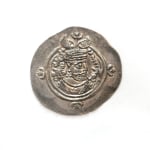Silver Drachm of Sassanid King Khosrow II, 531 CE - 579 CE
Silver
height 3.2 cm
height 1 1/4 in
height 1 1/4 in
C.6957
Obverse, bust of Khosrow I wearing winged crown with three merlons, three short diadem ties behind, crescent in front and surmounted by star and crescent; Pahlavi script, in the field;...
Obverse, bust of Khosrow I wearing winged crown with three merlons, three short diadem ties behind, crescent in front and surmounted by star and crescent; Pahlavi script, in the field; double pellet border with three radiate crescents and stars, encircling; reverse, two attendants flanking flaming altar, crescents on their heads; triple pellet border with four radiate crescents and stars, encircling. In AD 244 the Sassanid Dynasty, the last native Persian Kingdom to rule Ancient Iran was established. It was a golden age of Persian culture and heightened international trade and commerce. Excavations in China have unearthed gold and silver Sassanid coins covering a span of many centuries until the demise of the empire during the reign of Khosrow II. Khosrow I, who came to the throne in AD 531 is remembered as a great reformer and patron of the arts and scholarship. He is identifiable here by the distinct crown he wears. In other respects, the issue perpetrates the established Sassanian formula. The reverse also shows a common theme of Sassanian coinage and was symbolic for the Zoroastrianism religion the Sassanians followed.



